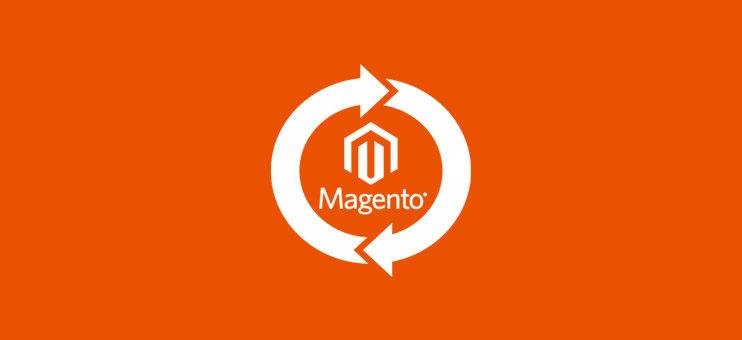
Introduction
Magento being a multifunctional professional open source solution is the world’s most popular*, content management system for eCommerce including the Enterprise solutions’ segment.
*For the market researches, please, visit the websites:
In this regard the migration from the deprecated eCommerce platforms to Magento Community or Magento Enterprise is a very popular customer request. This is usually required due to the trading site development when the shop needs a higher performance, scalable platform with a wider range of extensions and integrations.
The migration is often associated with the site’s design and functionality renewal which causes the customers’ concern in the matter of the shop’s operability and availability during such works.
But it is no use worrying about that. The work is performed in parallel on the external development server and does not influence the functionality of the existing shop. The substitution is the final stage when the ready revamped shop is published on the official domain.
We have big experience in the online shops’ migration from such platforms as:
- InSales
- Volusion
- Joomla/Virtuemart
- ZenCart
- PrestaShop
- Shopify
- osCommerce
- CS-Cart
- X-Cart
- etc.
Besides, we often face the migration requests within the Magento editions. Many eCommerce sites begin with the free Magento Community edition eventually moving to more advanced Magento Enterprise.
You can find our works on the migration in the portfolio on the website.
Migration process

1. Preparation
Preparation to “the moving” comprises two main stages – finding out all the details of point A and deciding upon point B, i.e.:
- Point A – the existing platform
- Point B – the new platform
The correct migration requires precise information on the version and the extensions of the existing platform as well as the old platform’s functions analysis. This will help to decide on the new system configuration, to choose or create modules required for the new shop operation (payment services, modules for your peculiar business-process, etc.).
The new platform choice is especially important as it determines the future capabilities of the shop.
Both Magento editions – free Community edition and commercial Enterprise edition - are well-suited for migration.
2. FUNCTIONS AND DEVELOPMENTS ANALYSIS
When all the necessary information on the old platform is received and the new platform is chosen it is required to compare the chosen systems’ functions.
Magento is famous for its functionality and scalability of modules. However the merchants’ needs are often rather specific and the standard box solution may just not have a required extension.
The Magento ecosystem has the official marketplace and lots of developers selling ready modules. That is why the lack of some functions in the box solution is not a problem. It is more complicated if the required module is not available.
But even this challenge can be completed. If the ready module does not exist it can be developed. As we mentioned above, the Magento community accounts for thousands developers capable to implement any tasks. Our advice is to address such issues to the certified developers only who had their knowledge affirmed on the international level, achieved official certification and are licensed to carry on the Magento development.
We are the official silver partners of Magento with all the required tests and verifications passed. The certified developers in our team had their knowledge affirmed on the international level. We are the only company in Russia having so many certified professionals which you can find on our website.
3. DATA TRANSFER
When the future shop functionality is clear it is required to decide what we need to transfer on the renewed site.
The most important elements are the following:
- Items and items attribute
- Items categories
- Purchase history (orders / invoices)
- Users/buyers (with passwords)
- Static pages/Content/Blog
- URL structure of the pages (very important to keep for SEO)
- Loyalty/discount system data
Generally not all these data can easily be transferred to the new platform. This depends on each specific eCommerce engine. That is why prior to the data transfer procedure it is essential to determine what can be exported from the previous CMS.
It also should be considered that only two of the listed points can easily be imported to Magento – Items and Users/buyers. The import of other elements presents some challenge that requires the developers’ involvement or third-party export modules.
4. DESIGN TRANSFER
There are two ways to deal with the design.
The first, simple one is to develop new up-to-date responsive design for the Magento platform. Such design can be developed either from scratch or on the basis of a ready theme that will be adapted for your brand.
If you want to keep your old design it can always be transferred without any fundamental changes. The basis will remain the same excluding some sections. Every CMS is specific and many features in Magento differ from the old systems, that is why some functional elements such as the customer’s profile and checkout process will be different. This is the reason why the old design has to be refined anyway.
If you decide to keep the old design in addition to the element adaptation we advise you to pay attention to the mobile version or the responsive design if your website does not have ones. This will ensure your shop is easily read and navigated not only on a desktop PC or a laptop but on any mobile device.
The fast-growing popularity and development of various mobile devices make the responsive web-design the best option for those who strive to cover all possible online sales channels. So nowadays it is no longer a luxury but an essential.
5. PRE-PUBLISHING TESTING
To ensure the high quality of the work the due consideration should be given to absolutely all stages of the project development. Each stage should undergo the QA (testing) process.
Besides the regular testing after each completed task we recommend to perform the User Acceptance Testing (UAT). This especially considers such an important issue as the shop’s platform change and transfer of the ready renewed site from the dev-server to the actual domain.
Prior to the substitution of the shop the quality of the performed work needs to be assured. The pre-publishing testing includes three large stages:
- Functional testing
- Cross browser testing
- Load testing
This testing is aimed to confirm that the system complies with all the necessary functional requirements and is completely ready to operate.
Required to check the correct operation of the online shop in different browsers.
Aimed to measure the website’s performance and speed.
When all the three points show positive results the next step can be fulfilled.
6. NEW HOSTING PREPARATION AND SETUP
Magento’s requirements to hosting may differ from the previous ones, so the server environment needs to be improved and adjusted. We recommend to use such modern technologies as Nginx, Redis, CDN.
In any case before new hosting preparation and setup it is better to consult the specialists. This will help to choose the optimum solution for the specific shop.
7. RENEWED SHOP TESTING
When the core of the subject – the renewed shop publishing and its final synchronization – is accomplished we can pass to the final testing of the completed project.
Similar to the previous stage of testing the shop undergoes thorough examination and passes the functional, cross browser and load testing as described above.
8. TECHNICAL SUPPORT
When the project work is completed we recommend taking the technical support service package which includes constant monitoring of the website operation and implementation of various improvements. It helps to respond efficiently to changes in work and guarantees continuous development of the online store.
Conclusion
Usually the complete migration process including the QA is similar in cost and time to the new project implementation regardless of the initial platform.
The only exception is the internal migration from Magento Community to Enterprise which takes less time and is performed by the abridged algorithm due to the single basis and existing almost identical Magento Enterprise modules.
For all that the online shop migration is a serious matter and it should be approached seriously In order to have no doubt in the decision made and no regrets for the money spent we recommend the trusted platform especially since it has an absolutely free Community edition.
Such global giants as Dior, Gant, Paul Smith, 20th Century Fox, Mothercare, Harper’s BAZAAR, Nike, Philips, Auchan, Olympus, Tool King, Angry Birds, Men's Health, Nestlé, Yves Rocher are already operating on Magento. Rejoin!
For details, please, contact our manager by hello@astrio.net

